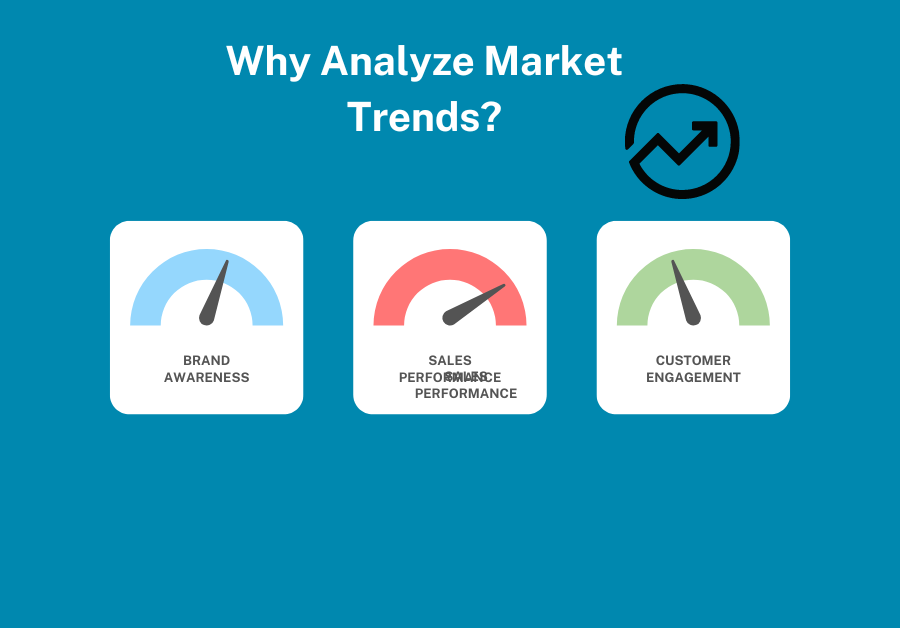Understanding market trends is like reading a map before you set off on a journey. It helps businesses and investors grasp the direction in which the market is moving. Whether it’s a new wave of consumer preferences or a shift in economic conditions, being aware of these trends can mean the difference between thriving and just surviving. In its essence, market trend analysis is the process of examining market data to predict future movements. This approach is critical for making informed decisions, whether you’re launching a new product, investing in stocks, or planning your next business move. With a keen eye on the market’s pulse, businesses can steer their strategies to align with what customers want next, not just what they wanted yesterday. By staying ahead of the curve, companies can carve out a competitive edge in a bustling marketplace, turning potential challenges into opportunities for growth.
What Is Market Trend Analysis?
Market trend analysis is the art of dissecting market data to spot patterns, understand current movements, and forecast future trends. It’s about looking closely at what has been happening in the market to make educated guesses about what might happen next. This analysis covers a broad range of data, from sales numbers and customer behavior to economic indicators and industry shifts.
At its core, this analysis aims to provide a clear picture of where the market is heading. This insight is invaluable for businesses and investors alike, as it guides strategic planning, product development, and investment decisions. By understanding the direction of market trends, companies can better position themselves to meet consumer needs, anticipate changes, and navigate through competitive landscapes with greater confidence.

Imagine being a captain at sea; market trend analysis is your compass and map, guiding you through the waters of market dynamics. It helps in making decisions that are not just reactive but proactive, enabling businesses to ride the waves of opportunity and steer clear of potential storms.
The Different Types of Market Trend Analyses
Market Trend Analysis is a multifaceted approach, encompassing various types of analyses that collectively paint a comprehensive picture of the business landscape. Let’s explore three key types:

Technical Analysis:
This method analyzes past market data, focusing mainly on prices and trading volumes. Traders and analysts use charts and statistical tools to spot patterns, trends, and possible changes in the market. It relies on quantitative data and helps in understanding past market behavior to predict future trends.
Fundamental Analysis:
This type differs from technical analysis as it looks into the true value of an asset or market. It examines economic indicators, financial statements, and industry trends to evaluate a business’s health and growth potential. Understanding these fundamental elements helps businesses make decisions based on the real strength of an asset.
Sentiment Analysis:
With the rise of social media and instant communication, sentiment analysis has become important. It measures the attitudes and opinions of market participants by analyzing social media posts, news articles, and other textual data. Knowing the general sentiment offers insights into possible market movements.
Each type offers a distinct viewpoint, leading to a comprehensive understanding of market trends. Technical analysis provides a historical perspective, fundamental analysis investigates the core health of a market, and sentiment analysis reflects the current mood. Combining these analyses gives businesses a deeper insight into market dynamics.
Why Analyze Market Trends?
Analyzing market trends is not just about keeping up with the competition; it’s about staying ahead. Here are several reasons why this analysis is indispensable:
Informed Decision-Making: Armed with insights into where the market is headed, businesses can make decisions that are not just reactive but proactive. Whether it’s launching a new product, entering a new market, or adjusting marketing strategies, trend analysis provides a data-driven foundation for these decisions.
Risk Management: By identifying trends early, companies can better anticipate and mitigate risks. For example, a downward trend might signal the need to cut costs or diversify offerings, while an upward trend could indicate an opportunity to invest in growth.
Opportunity Identification: Trend analysis helps businesses spot emerging opportunities before they become obvious to everyone. This early detection is crucial in today’s fast-paced markets, where being even a step ahead can lead to significant advantages.
Customer Insights: Trends provide valuable insights into customer behavior, preferences, and needs. Understanding these changes allows businesses to adapt their products and services, ensuring they remain relevant and appealing.
Strategic Planning: Long-term strategic planning benefits greatly from trend analysis. It helps in setting realistic goals, forecasting future scenarios, and preparing for potential market shifts.

In essence, market trend analysis equips businesses with the foresight needed to navigate through uncertain waters, seize opportunities, and steer clear of potential pitfalls. It’s an essential practice for anyone looking to thrive in today’s dynamic market landscape.
Tools and Techniques for Analyzing Market Trends
To navigate the complex landscape of market trends, businesses and analysts employ a variety of tools and techniques. These range from sophisticated software to fundamental analysis methods. Here’s a look at some key approaches:
Data Analysis Software: With advancements in technology, there are now numerous software options designed to sift through vast amounts of market data. These tools can track sales, monitor social media trends, analyze consumer behavior, and more, providing a comprehensive view of the market landscape.
Surveys and Customer Feedback: Directly gathering information from consumers through surveys, feedback forms, and social media can offer invaluable insights into current trends and predict future shifts in preferences and behavior.

Economic Indicators: Key economic indicators such as GDP growth rates, unemployment rates, and consumer spending figures are crucial for understanding the broader market environment. These indicators can signal economic health and potential market trends.
Competitor Analysis: Keeping an eye on competitors can provide clues about where the market is heading. Changes in competitors’ strategies, product launches, and marketing campaigns can serve as indicators of emerging trends.
Technical Analysis: Often used in the financial markets, technical analysis involves studying historical price movements and trading volumes to forecast future market behavior. This technique can also apply to broader market trend analysis, especially for pricing strategies and demand forecasting.
Expert Insights and Industry Reports: Analyst reports, industry conferences, and expert commentary can offer high-level insights into market trends and future outlooks. These sources are particularly valuable for understanding nuanced industry-specific dynamics.
By leveraging these tools and techniques, businesses can piece together a detailed picture of the market, identifying not only current trends but also forecasting future movements. This comprehensive approach is essential for developing strategies that are both resilient and adaptable.
Identifying Market Opportunities and Threats
A crucial aspect of market trend analysis is the ability to spot both opportunities and threats within the market landscape. Here’s how businesses can navigate this critical task:
Spotting Opportunities
- Emerging Trends: By staying attuned to the early signs of emerging trends, companies can capitalize on new market demands before they become mainstream. This could involve innovative products, new customer segments, or untapped markets.
- Gap Analysis: Analyzing the current market offerings versus customer needs can reveal gaps in the market. Filling these gaps can create significant opportunities for businesses.
- Technological Advances: Technological developments often herald new market opportunities. Companies at the forefront of adopting and integrating new technologies can gain a competitive edge.

Identifying Threats
- Competitive Moves: Changes in competitors’ strategies, such as new product launches or pricing adjustments, can pose threats. Keeping a close eye on these moves helps businesses respond strategically.
- Changing Consumer Preferences: Shifts in what consumers want and value can make existing products or services obsolete. Regular market trend analysis helps anticipate and adapt to these changes.
- Economic Shifts: Economic downturns or instability in specific sectors can threaten business performance. Monitoring economic indicators helps businesses brace for and navigate through tough times.
To identify these opportunities and threats, businesses use various tools and techniques, including SWOT analysis (Strengths, Weaknesses, Opportunities, Threats), PESTLE analysis (Political, Economic, Social, Technological, Legal, Environmental), and scenario planning. These methods help in systematically assessing the external and internal factors affecting the market and the business itself.
Applying Market Trend Analysis
Putting market trend analysis into action is where the strategic insights gained transform into competitive advantages. Here are practical ways businesses apply this analysis:
Product Development: By understanding emerging trends, companies can innovate or modify their products to meet new market demands. This proactive approach ensures that their offerings remain relevant and desirable to consumers.
Marketing Strategies: Market trend analysis informs marketing efforts, helping businesses tailor their messaging and channels to current consumer preferences and behaviors. This targeted approach can significantly enhance the effectiveness of marketing campaigns.
Investment Decisions: For investors and businesses alike, trend analysis plays a crucial role in making informed investment choices. By predicting which sectors or stocks are poised for growth, investors can allocate their resources more strategically.
Supply Chain Management: Trends in technology, consumer demand, and global trade policies can impact supply chain logistics. Businesses that anticipate these changes can adapt their supply chain strategies to maintain efficiency and reduce costs.
Expansion Plans: When considering entry into new markets or expansion within existing ones, trend analysis provides insights into market readiness, potential demand, and competitive landscapes. This information is vital for timing market entry and scaling operations effectively.

Risk Management: Identifying potential threats through trend analysis allows businesses to develop contingency plans, reducing the impact of adverse market shifts on operations and financial performance.
Challenges and Limitations of Market Trend Analysis
While market trend analysis is undeniably valuable for informing business strategy, it’s not without its challenges and limitations. Recognizing these hurdles is key to effectively leveraging market insights. Here are some common challenges businesses may face:
Data Overload: In today’s digital age, companies have access to vast amounts of data. Sifting through this data to find relevant insights can be overwhelming. Identifying the most valuable data sources and using advanced analytics can help manage this challenge.
Rapid Market Changes: Markets can shift quickly due to new technologies, changing consumer preferences, or global events. Keeping up with these rapid changes requires agility and the willingness to adjust strategies as needed.

Predictive Uncertainty: While trend analysis can provide insights into potential future movements, predictions are never guaranteed. Market conditions are influenced by numerous unpredictable factors, making absolute certainty impossible.
Bias and Subjectivity: Analyzing trends involves interpreting data, which can introduce personal biases. Ensuring a diverse set of perspectives and leveraging data analytics tools can help mitigate this risk.
Cost and Resources: Conducting comprehensive market trend analysis can be resource-intensive. Small and medium-sized enterprises (SMEs) may find it challenging to allocate the necessary funds and manpower.
Despite these challenges, there are strategies to overcome them and make the most of market trend analysis:
- Leverage Technology: Use advanced data analytics and AI tools to process and analyze data more efficiently.
- Stay Agile: Cultivate a flexible business model that can quickly adapt to market changes.
- Diversify Sources: Gather insights from a variety of sources to get a well-rounded view of the market.
- Continuous Learning: Keep updating your knowledge and stay informed about new analysis methods and tools.
- Strategic Prioritization: Focus your analysis on key areas that have the most significant impact on your business.
The Future of Market Trend Analysis
Looking ahead, the future of market trend analysis is promising, with advancements in technology playing a pivotal role. Big data analytics, AI, and machine learning are becoming increasingly sophisticated, enabling businesses to gain deeper and more accurate insights into market trends. Additionally, the rise of real-time data analysis allows companies to react more swiftly to market changes.
Moreover, as businesses become more globally interconnected, understanding regional and global market trends will become even more crucial. Companies that can effectively analyze and adapt to these trends will be better positioned to thrive in an increasingly competitive landscape.

Conclusion
Market trend analysis is an essential component of strategic business planning, offering insights that help businesses capitalize on opportunities and navigate challenges. Despite its limitations, the benefits of informed decision-making and strategic foresight make it a valuable practice for companies looking to stay competitive and grow in a dynamic market environment. By embracing new technologies and methodologies, businesses can overcome the challenges of market trend analysis and leverage its full potential for future success.






